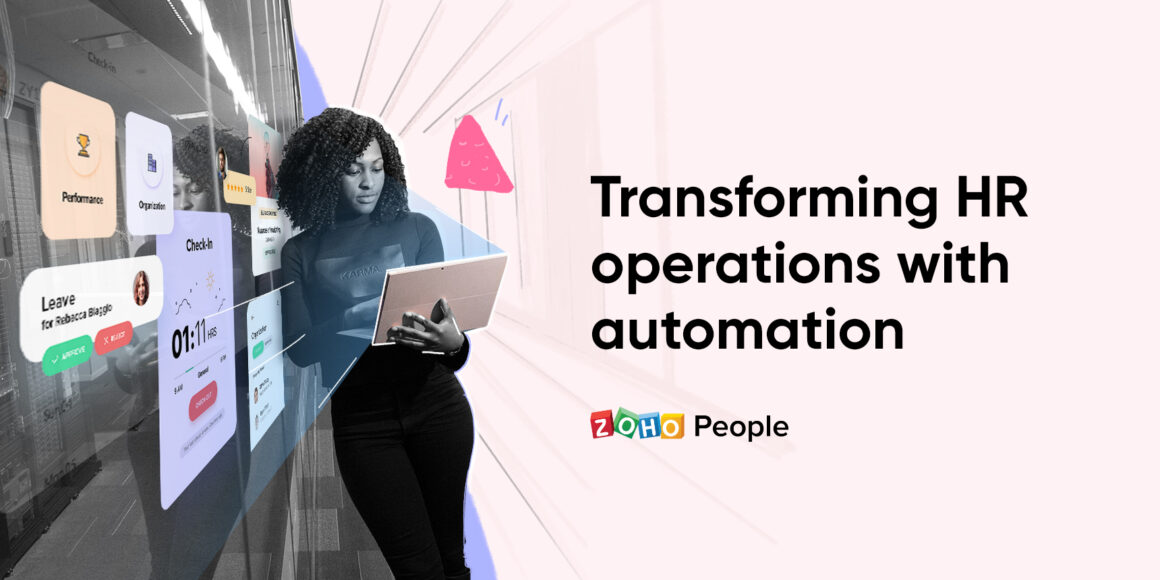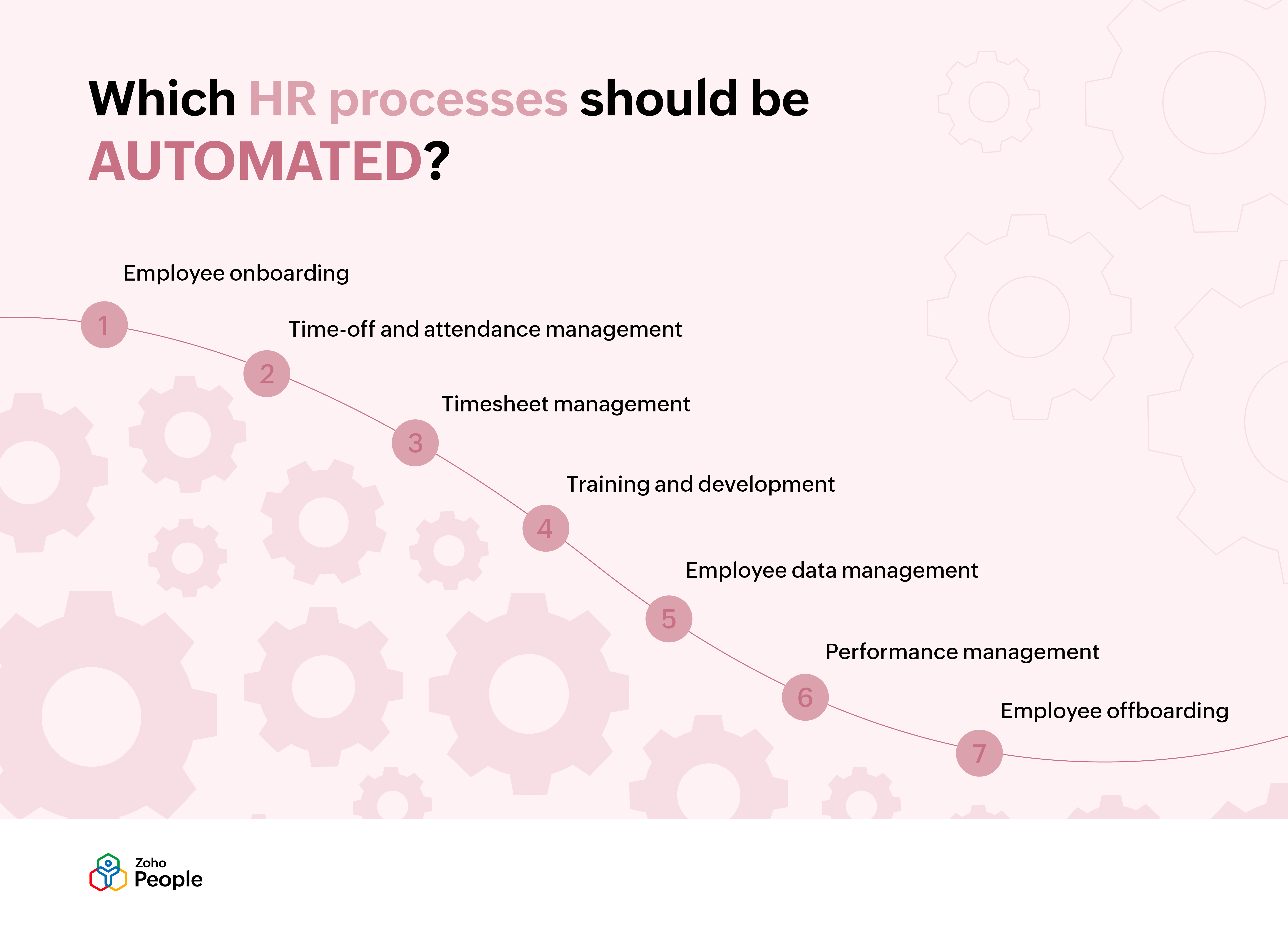- HOME
- More
- HR for SMBs
- HR automation: What to use it for and why
HR automation: What to use it for and why
- Last Updated : April 16, 2024
- 6.6K Views
- 9 Min Read

When handled effectively, human resource management can make a positive difference in the way your employees work. HR professionals play a key role in the entire employee journey, from hiring to offboarding. How you run your HR operations sets the foundation for your organizational culture and employee productivity, well-being, and happiness.
Having tedious and repetitive HR processes that take a substantial amount of your employees’ time can shift the focus away from more important HR initiatives. This can cause frustration to build among your workers, leading to a poor employee experience.
Ensuring that the internal HR functions in your organization are updated will help you maintain satisfaction among your modern workforce. This is one reason why HR automation is becoming more popular than ever. Willis Towers Watson found that 17% of work processes will be automated by the end of 2020.
What is HR automation?
As the name suggests, HR automation is the process of automating manual, repetitive, and mundane HR tasks to make them more competitive and efficient. This helps businesses cut administrative costs and focus on other pressing workplace issues, such as interpersonal conflict, diversity management, performance reviews, change management, and digital workspaces. HR automation facilitates the creation of workflows to simplify everything from day-to-day HR operations to other repetitive tasks like sending emails, creating schedules, and more.
How does automation help your HR department?
Automation is beneficial in all areas of business, but it’s especially helpful for your HR department. Without a proper system in place, your HR staff can get loaded down with manual administrative tasks. Here are four ways that automation benefits HR.
1. It simplifies HR processes
HR tech can greatly improve the employee experience in your organization. By automating all essential HR functions, your employees will be able to get their work done much faster. For example, when you automate your time-off management process, employees can apply for time off in just a few easy steps. You and the reporting managers can approve the time-off request with just a click instead of being forced to go through a stack of paperwork. Because everything is automated in a single system, employees can also find any information they need online.
2. It increases cost savings
The HR department is a major contributor to business expenditures. Automating your manual HR operations can help your organization save a substantial amount of money. Because the information is stored online, you can save the money you previously spent on paperwork and storage space. With automation, it’s much less likely that you’ll miss a vital HR task. This prevents the penalties caused due to non-compliance. You’ll also have more clarity on what’s working and what’s not working, saving you money on initiatives that aren’t producing results.
3. It prevents data errors
As an HR professional, you have to deal with tons of employee data. Managing this data manually can make it impossible to avoid errors. These errors can affect different levels of your organization, reducing the overall efficiency of your operations. HR automation has built-in triggers for automatic data field updates whenever there’s a change. This goes a long way in reducing data errors, preventing double work, and keeping your information current and consistent.
4. Boosts productivity
With manual HR management, an enormous amount of time is spent completing HR tasks, following up with employees, and correcting any errors in data. This hinders your productivity and reduces the time spent on other strategic tasks. HR automation frees you from sending multiple emails and managing hundreds of spreadsheets. Any information you need is just a search away, so you don’t have to search through piles of documents or spreadsheets.
Which HR processes should be automated?

1. Employee onboarding
The paperwork that comes with new hire onboarding is tremendous, and this can be overwhelming for both you and your new employees. Impediments in the process can lead to negative new hire experiences, reducing employee confidence in your organization.
With that being the case, automation is highly recommended for new hire onboarding. All paperwork can be shared, signed, and saved online. You can include documents that give your new hires information about your company policies, their team, job responsibilities, and more in an employee portal. This streamlined process will appeal to a modern workforce and benefit your organizational culture.
2. Time-off and attendance management
Attendance and time off are two of the most essential HR functions, and you must be able to manage them well to improve employee morale and ensure compliance. By automating time-off and attendance management, your employees can:
Mark their attendance online
Apply for time off online
Check the status of time-off requests
View their attendance data and time-off balances
Furthermore, you can:
Customize attendance and time-off settings
Access time-off and attendance data anytime
Approve or reject time-off requests instantly from anywhere
Generate reports to understand overall attendance and time-off trends
3. Timesheet management
Manually managing multiple projects at a time can be tiring and imperfect. Recording timesheets in spreadsheets can be a time-consuming process. With timesheet automation, you can fix these issues. Recording the hours spent on different projects is as simple as switching on a timer. Your employees can send their online timesheet for approval, and you can reject or approve them right away. This makes tracking time accurate, quick, and error-free, and, in turn, that makes payroll and invoicing more efficient.
4. Training and development
Automation can make employee training and development seamless by preventing time and geographical constraints. Taking your learning programs online allows you to train any number of employees at once. Multiple courses can be created online, and employees can choose the courses that are relevant to their job responsibilities. They can also complete their assessments online.
5. Employee data management
Automating data management can be extremely beneficial to the HR department. Employees can track and manage their own personal data, and you can just oversee it. This will take some amount of work off your shoulders. Another big advantage of data automation is that it consolidates all essential data in a single place, which businesses can use to make business decisions effectively. Automation doesn’t mean sacrificing security, either. Everything is password-protected, so your data and workflows remain safe.
6. Performance management
Conducting annual performance reviews manually has become a thing of the past. An automated performance management process can go a long way in helping employees align their performance to organizational goals. It prevents the implicit bias associated with manual performance management by gaining inputs from managers and coworkers without the need for face-to-face meetings. It standardizes the whole process and makes performance reviews continuous and meaningful. With a better employee review system, you can enhance your organization’s productivity and improve your workforce’s motivation.
7. Employee offboarding
Just like onboarding, offboarding also involves multiple steps, including filling out forms, handing over account credentials, and turning in hardware. Automation can make it as smooth as possible for your employees while also keeping the process compliant with all legal regulations. You can use the data collected automatically to generate valuable insights and improve the employee retention rate of your organization.
What are some examples of HR automation?
HR process automation is all about cutting down on repetitive tasks and simplifying day-to-day HR operations. Here are some key examples of HR automation and how it can be helpful to HR teams and employees.
1. Onboarding automation
When it comes to onboarding, HR automation can simplify most tasks. For instance, HR teams can set up a workflow to trigger automated welcome emails to new hires as soon as they join your organization. This way, you don't have to send emails manually when you have new hires joining your organization. Similarly, you can have dedicated forms to collect important documents from employees. Once new hires fill them out, the centralized database will store them automatically.
2. Time and attendance automation
When it comes to time and attendance, you can automate and simplify the entire time-tracking process with HR automation software. This software allows you to integrate your existing biometric system so that when employees punch in their attendance, the software automatically tracks and documents it. The system will also automatically track any overtime hours.
Similarly, when it comes to managing shift schedules, you can set up workflows to automate the entire process of shift rotation. Worklows can be set up to move employees from one shift to another, and emails can be set automatically to notify them about the change.
3. Leave automation
Multiple aspects of leave management can be automated. For instance, leave applications can be automated and simplified by providing employees access to a self-service portal through which they can apply for leave with a form that’s easy to fill out. Based on the criteria that you set for approvals, the leave application can be transferred to employees from different roles for approval. You can also set a condition to auto-approve or auto-reject leave requests.
4. Performance management automation
When it comes to performance management, using HR automation can help you track employee goals and competencies, key result areas, and more. For instance, when it comes to goals, you can add goals for a particular employee, set a weightage for it, associate certain tasks to those goals, and track how employees progress towards those goals effortlessly.
What is an HR automation software?
HR automation software is a comprehensive technology that frees up HR teams from manual tasks and simplifies and automates operations such as onboarding new hires and managing employees’ leave, time, and attendance. It can also handle employee leave requests, run performance reviews, and much more. It's basically used to enhance HR efficiency by saving these teams from the administrative burden and helping them focus on more strategic tasks.
What are the must-have features of every HR automation software?
Here are five features that you should definitely look for in your next HR automation software:
1. Rich features
The HR automation software that you select should automate, streamline, and simplify all of your processes, from onboarding to offboarding. It should have a separate module to help HR teams manage each of these processes effortlessly without cluttered screens or complex navigations.
2. Integration capabilities
Because automation is all about cutting down on duplicate work and repetitive tasks, the HR automation software should easily integrate with your existing systems. For instance, if you have a payroll system in place, it should integrate with it and automatically sync the attendance, leave, and loss of pay data required for payroll calculation.
3. Customization capabilities
In addition to supporting automation functionalities, your HR automation software should also support custom workflows so that you're able to make use of it in a way that makes the system consistent with your organization's HR needs. You should be able to set up those workflows easily.
4. Data reporting
Because employee data is one of the most important aspects of HR, your HR automation software should help you visualize employee data to make informed decisions for your employees. For instance, it should help you stay on top of employee attrition rates, addition rates, employee demographics, and more without having to spend valuable time creating charts.
5. Compliance
Compliance should be at the heart of your HR automation software. It should stay on top of all labor laws governing your country or region and manage HR operations in a way that complies with those laws.
Final thoughts
Over the years, the strategic role of the HR department in the overall development of an organization has increased rapidly. Every HR operation should be managed effectively to improve employee experience and avoid compliance issues. HR automation can make this much easier. Automation has the potential to free HR professionals from the burden of these administrative tasks. The technology is evolving all the time to make this automation process more efficient, so HR professionals must stay on top of current solutions to stay competitive.
Zoho People, our HR software, can automate and transform all of the essential HR functions of your organization. You can use our software the way you want to meet the unique requirements of your workforce. Learn how Zoho People can automate all of your HR functions here.
Also read:Why SpiceJet chose Zoho People for better and simpler HR management.
 Tarika
TarikaContent Specialist at Zoho People


